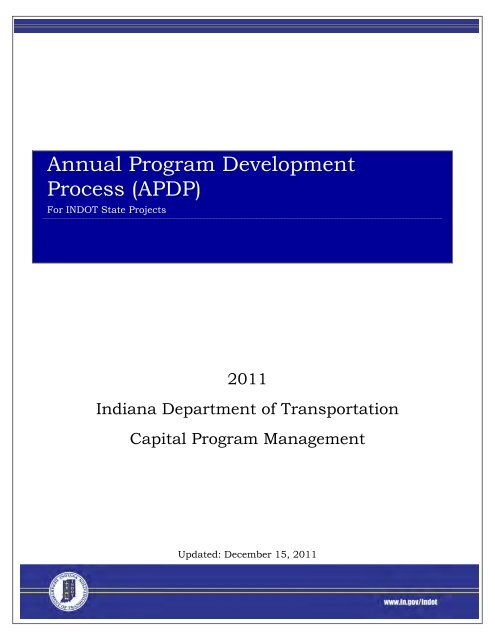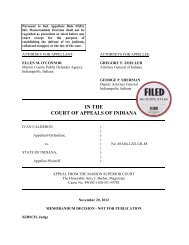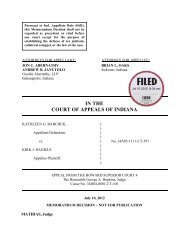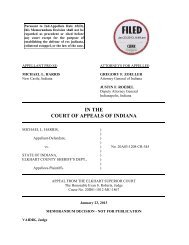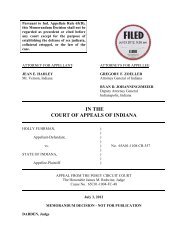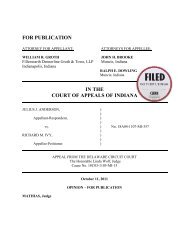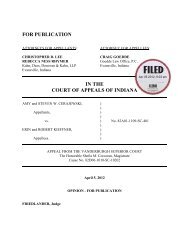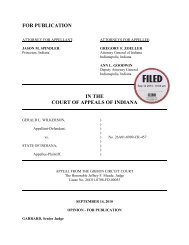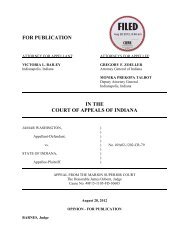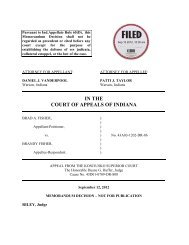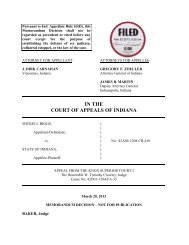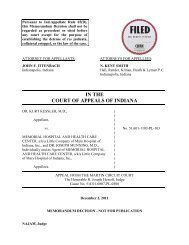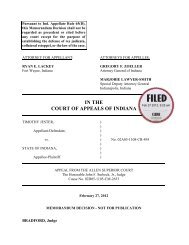Annual Program Development Process (APDP) - State of Indiana
Annual Program Development Process (APDP) - State of Indiana
Annual Program Development Process (APDP) - State of Indiana
Create successful ePaper yourself
Turn your PDF publications into a flip-book with our unique Google optimized e-Paper software.
<strong>Annual</strong> <strong>Program</strong> <strong>Development</strong><br />
<strong>Process</strong> (<strong>APDP</strong>)<br />
For INDOT <strong>State</strong> Projects<br />
2011<br />
<strong>Indiana</strong> Department <strong>of</strong> Transportation<br />
Capital <strong>Program</strong> Management<br />
Updated: December 15, 2011
<strong>Annual</strong> <strong>Program</strong> <strong>Development</strong> <strong>Process</strong> (<strong>APDP</strong>) December 15, 2011<br />
Contents<br />
INTRODUCTION ................................................................................................................................ 3<br />
PUBLIC & STAKEHOLDER INVOLVEMENT ................................................................................................... 4<br />
INDOT PLANNING PARTNERS ................................................................................................................. 5<br />
PLANNING DOCUMENTS AND PROGRAMS ................................................................................................. 8<br />
LONG RANGE PLANNING (11‐20 YEARS) .............................................................................................. 9<br />
INDOT 5‐YEAR CONSTRUCTION PLAN (1‐5 YEARS) ............................................................................. 12<br />
INDOT STATEWIDE TRANSPORTATION IMPROVEMENT PROGRAM (0‐4 YEARS) ........................................ 12<br />
ASSET MANAGEMENT ..................................................................................................................... 13<br />
ANNUAL PROGRAM DEVELOPMENT PROCESS 5‐STAGES ........................................................................... 15<br />
STAGE I: CALL FOR NEW STATE PROJECTS & PROGRAM REVISIONS ......................................................... 15<br />
STAGE II: STATEWIDE REVIEW AND PROGRAM UPDATE......................................................................... 17<br />
STAGE III: DRAFT STIP AND 5‐YEAR CONSTRUCTION PLAN DEVELOPMENT .............................................. 19<br />
STAGE IV: STIP DEVELOPMENT AND COORDINATION WITH MPO TIPS ................................................... 20<br />
STAGE V: STIP PUBLICATION ........................................................................................................ 21<br />
STIP PROGRAM SUPPORT FUNCTIONS AND AMENDMENTS ‐ OVERVIEW .................................................. 22<br />
APPENDIX A: ANNUAL SCHEDULE .......................................................................................................... 23<br />
APPENDIX B: STIP AMENDMENT: NOTIFICATION CRITERIA .............................................................. 24<br />
I. PURPOSE ............................................................................................................................ 24<br />
II. DEFINITIONS: ..................................................................................................................... 24<br />
III. CRITERIA FOR STIP/TIP AMENDMENTS ............................................................................... 25<br />
IV. AMENDMENT PROCEDURES/RESONSIBILITIES .............................................................. 27<br />
VI. CRITERIA FOR NOTIFICATIONS‐STIP/TIPS (FOR ADMINISTRATIVE MODIFICATIONS) ................ 28<br />
VI. NOTIFICATION PROCEDURES AND RESPONSIBILITIES .................................................... 28<br />
APPENDIX C: STIP AMENDMENT REQUEST PROCESS ................................................................................ 29<br />
APPENDIX D: INDOT DIVISION STRUCTURE ............................................................................................ 32<br />
INDOT DISTRICT OFFICES ................................................................................................................ 32<br />
INDOT CAPITAL PROGRAM MANAGEMENT BUSINESS UNIT .................................................................. 33<br />
MPO/LPA GRANT ADMINISTRATION DIVISION ................................................................................... 33<br />
INDOT FINANCE BUSINESS UNIT ...................................................................................................... 34<br />
APPENDIX E: CALL‐FOR‐PROJECT FORM ................................................................................................. 35<br />
2 Introduction | <strong>Indiana</strong> Department <strong>of</strong> Transportation
<strong>Annual</strong> <strong>Program</strong> <strong>Development</strong> <strong>Process</strong> (<strong>APDP</strong>) December 15, 2011<br />
<strong>Annual</strong> <strong>Program</strong> <strong>Development</strong> <strong>Process</strong><br />
(<strong>APDP</strong>)<br />
For INDOT <strong>State</strong> Projects<br />
Introduction<br />
The <strong>Indiana</strong> Department <strong>of</strong> Transportation (INDOT) has prepared the <strong>Annual</strong> <strong>Program</strong> <strong>Development</strong><br />
<strong>Process</strong> – <strong>State</strong> (<strong>APDP</strong>). The <strong>APDP</strong> is a comprehensive set <strong>of</strong> procedures for project development on the<br />
INDOT state highway jurisdictional system, which includes: interstates, US Highways, and state roads. A<br />
separate <strong>Annual</strong> <strong>Program</strong> <strong>Development</strong> <strong>Process</strong> has been developed for local (non‐state jurisdictional<br />
facilities) systems known as the <strong>APDP</strong>‐L is available on INDOT’s website:<br />
http://www.in.gov/indot/files/PDP_L(1).pdf.<br />
The <strong>APDP</strong> process provides the mechanism for identifying transportation needs and programming <strong>of</strong><br />
major capacity projects considered for inclusion in the INDOT Long Range Transportation Plan, INDOT 5‐<br />
year Construction <strong>Program</strong>, and the INDOT <strong>State</strong> Transportation Improvement <strong>Program</strong> (STIP).<br />
The <strong>APDP</strong> consists <strong>of</strong> five stages as described as follows. Each <strong>of</strong> these stages will be discussed in more<br />
detailed in the <strong>APDP</strong> document:<br />
<br />
<br />
<br />
<br />
<br />
Stage I: Call for New <strong>State</strong> Projects and <strong>Program</strong> Revisions<br />
Stage II: <strong>State</strong>wide Review and <strong>Program</strong> Update<br />
Stage III: Draft INDOT STIP and 5‐Year Construction Plan Documents<br />
Stage IV: Document Coordination with INDOT Planning Partner’s Long‐Range Metropolitan<br />
Transportation Plans and Transportation Improvement <strong>Program</strong>s (TIP)<br />
Stage V: Update <strong>of</strong> <strong>State</strong> Transportation Improvement <strong>Program</strong> (STIP), 5‐Year Construction<br />
<strong>Program</strong>; and Long‐Range Transportation Plan document publications (as needed)<br />
The <strong>APDP</strong> transportation decision‐making approach provides a seamless process from planning through<br />
construction and encourages open communication for making informed decisions during all stages <strong>of</strong><br />
project development. By involving all disciplines at the earliest stages <strong>of</strong> the process, issues affecting<br />
project type, scope, preliminary engineering, design, and cost are identified in advance. Resolving these<br />
issues in the early stages minimizes project development delays, while allowing the development and<br />
review <strong>of</strong> more context appropriate alternative improvements.<br />
<strong>Indiana</strong> Department <strong>of</strong> Transportation | Introduction 3
<strong>Annual</strong> <strong>Program</strong> <strong>Development</strong> <strong>Process</strong> (<strong>APDP</strong>) December 15, 2011<br />
Public & Stakeholder Involvement<br />
In the transportation decision‐making process, public<br />
and stakeholder involvement is a key federally<br />
required component in the ADPD process, especially<br />
for major projects (new corridors, added travel lanes,<br />
new interchanges, and projects with costs reaching<br />
over $5 million). Public and stakeholder involvement<br />
needs to be an early and continuing part <strong>of</strong> the<br />
transportation and project development process.<br />
Stakeholders are defined as individuals and groups<br />
who are, or may be impacted by, or have an interest in<br />
a project. In some cases, federal regulations define<br />
who stakeholders are. Typically stakeholders include:<br />
elected and appointed <strong>of</strong>ficials; the general public;<br />
businesses; environmental justice populations; and<br />
pr<strong>of</strong>essional and technical staff from both INDOT and<br />
affected local governments agencies impacted by<br />
transportation decisions.<br />
INDOT has prepared the INDOT Public Involvement<br />
<strong>Process</strong> (PIP) Manual to provide guidance to those<br />
who are engaged in providing public involvement<br />
opportunities related to INDOT decisions and actions<br />
and to let the public know what they can expect in<br />
terms <strong>of</strong> INDOT public involvement policies and<br />
practices. This manual is primarily addressed to INDOT<br />
staff and their consultants who will carry out INDOT’s<br />
public involvement activities. The manual and<br />
additional details on INDOT’s public involvement<br />
process and related procedures can be found on<br />
INDOT’s website: http://www.in.gov/indot/2366.htm<br />
Examples <strong>of</strong> Stakeholders:<br />
Civic & Community Associations<br />
Department <strong>of</strong> Natural Resources<br />
Environmental Justice Populations<br />
Federal Highway Administration<br />
Federal Transit Agency<br />
Freight, Rail, & Aviation<br />
Associations<br />
General Public<br />
<strong>Indiana</strong> Department <strong>of</strong><br />
Environmental Management<br />
(IDEM)<br />
Local Public Agency<br />
Local Transit Agency<br />
Metropolitan Planning<br />
Organization (MPOs)<br />
Resource Agencies<br />
Rural Planning Organizations<br />
(RPO)<br />
Special Interest Groups<br />
U.S. Environmental Protection<br />
Agency (EPA)<br />
Many Others<br />
4 Public & Stakeholder Involvement | <strong>Indiana</strong> Department <strong>of</strong> Transportation
<strong>Annual</strong> <strong>Program</strong> <strong>Development</strong> <strong>Process</strong> (<strong>APDP</strong>) December 15, 2011<br />
INDOT Planning Partners<br />
Federal Highway Administration (FHWA) ‐ The FHWA oversees federal funds used for the design, right<strong>of</strong>‐way<br />
acquisition, construction, and maintenance <strong>of</strong>: Interstate Highways, U.S. Routes, <strong>State</strong> Routes,<br />
and Federal‐Aid funded route facilities. FHWA’s role is to ensure projects using these funds meet federal<br />
requirements in terms <strong>of</strong> project eligibility, planning, environmental, contract administration, right‐<strong>of</strong><br />
way, and construction standards. For additional information regarding FHWA, federal regulations, and<br />
contact information, please visit the <strong>Indiana</strong> Division <strong>of</strong> FHWA website:<br />
http://www.fhwa.dot.gov/indiv/index.htm.<br />
<strong>Indiana</strong> Metropolitan Planning Organizations<br />
Northwest<br />
<strong>Indiana</strong><br />
Lafayette-<br />
Tippecanoe<br />
Co.<br />
South<br />
Bend-<br />
Elkhart<br />
Muncie-<br />
Delaware<br />
Co.<br />
Kokomo-<br />
Howard Co.<br />
<strong>Indiana</strong>polis<br />
Anderson-<br />
Madison<br />
Co.<br />
Fort Wayne<br />
Federal Transit Administration (FTA) –<br />
FTA provides stewardship <strong>of</strong> combined<br />
formula and discretionary programs to<br />
support a variety <strong>of</strong> locally planned,<br />
constructed, and operated public<br />
transportation systems throughout the<br />
United <strong>State</strong>s. Transportation systems<br />
typically include: buses, subways, light<br />
rail, commuter rail, streetcars, monorail,<br />
passenger ferry boats, inclined railways,<br />
or people movers. For additional<br />
information regarding FTA, federal<br />
regulations, and contact information,<br />
please visit the FTA website:<br />
http://www.fta.dot.gov and select FTA<br />
Region 5, which represents: Illinois,<br />
Ohio, Minnesota, Wisconsin, <strong>Indiana</strong>,<br />
and Michigan.<br />
Terre<br />
Haute-<br />
Vigo Co.<br />
Evansville<br />
Bloomington-<br />
Monroe<br />
Co.<br />
Columbus-<br />
Edinburgh<br />
Louisville<br />
Cincinnati-<br />
Dearborn<br />
Co.<br />
Metropolitan Planning Organizations<br />
Madison Co. Council <strong>of</strong> Governments<br />
Bloomington- Monroe Co. MPO<br />
Ohio-Kentucky-<strong>Indiana</strong> Regional Council <strong>of</strong> Governments<br />
Columbus Area MPO<br />
Evansville MPO<br />
Northeastern <strong>Indiana</strong> Coordinating Council<br />
<strong>Indiana</strong>polis MPO<br />
Kokomo/Howard Co. Governmental Coordinating Council<br />
The Area Plan Commission <strong>of</strong> Tippecanoe Co.<br />
Kentucky-<strong>Indiana</strong> Planning & <strong>Development</strong> Agency<br />
Delaware-Muncie Metropolitan Plan Commission<br />
Northwestern <strong>Indiana</strong> Regional Planning Commission<br />
Michiana Area Council <strong>of</strong> Governments<br />
West Central <strong>Indiana</strong> Economic <strong>Development</strong> District<br />
Metropolitan Planning Organizations<br />
(MPOs) ‐ MPOs are federally required<br />
transportation planning bodies<br />
comprised <strong>of</strong> elected and appointed<br />
<strong>of</strong>ficials representing local, state and<br />
federal governments or agencies having<br />
interest or responsibility in<br />
transportation planning and<br />
programming. In urbanized areas <strong>of</strong><br />
50,000 or more, transportation planning<br />
by the state is done in cooperation with<br />
the MPO. The MPO develops a number<br />
<strong>of</strong> federal planning documents; manages<br />
both local and state projects in there<br />
respected areas; and performs various<br />
support related transportation planning<br />
activities.<br />
<strong>Indiana</strong> Department <strong>of</strong> Transportation | INDOT Planning Partners 5
<strong>Annual</strong> <strong>Program</strong> <strong>Development</strong> <strong>Process</strong> (<strong>APDP</strong>) December 15, 2011<br />
MPOs play a vital role in the planning and development <strong>of</strong> transportation projects and services<br />
throughout the urbanized areas <strong>of</strong> <strong>Indiana</strong>. Together with the INDOT District Offices, they serve as<br />
primary sources <strong>of</strong> local input and as fundamental cooperating partners in the mode‐specific planning<br />
and program implementation process. <strong>Indiana</strong>’s fourteen MPOs have jurisdictional responsibility for<br />
transportation planning in urbanized areas.<br />
For more information on <strong>Indiana</strong>’s MPOs and contact information for each MPO agency, please visit the<br />
<strong>Indiana</strong> MPO Council website: http://www.indianampo.com<br />
Rural Planning Organizations (RPOs) – Also known as Regional Planning Organizations, serve the<br />
transportation planning needs <strong>of</strong> small urban and rural areas <strong>of</strong> the state. RPOs perform eligible<br />
planning activities in order to provide planning support to local communities. The planning activities <strong>of</strong><br />
RPOs are aimed at supporting INDOT Central and District Office Planning staff with public outreach,<br />
technical assistance to local <strong>of</strong>ficials and the collection <strong>of</strong> transportation‐related data.<br />
RPOs are also responsible for<br />
transportation planning funds in the<br />
form <strong>of</strong> a matching grant to regional<br />
planning commissions.<br />
Non‐MPO Areas –Include small towns<br />
and cities not included in an MPO area.<br />
INDOT’s non‐metropolitan local <strong>of</strong>ficial<br />
consultation process is based <strong>of</strong>f 23 CFR<br />
450.210(b); which states:<br />
Regional Planning Organizations<br />
Northwestern<br />
<strong>Indiana</strong> Regional<br />
Planning<br />
Commission<br />
Kankakee-Iroquois<br />
Regional<br />
Planning<br />
Commission<br />
Michiana Area<br />
Council <strong>of</strong><br />
Governments<br />
<strong>Development</strong><br />
District &<br />
Regional<br />
Planning<br />
Commisison Northeastern<br />
<strong>Indiana</strong><br />
Regional<br />
Coordinating<br />
Council<br />
The <strong>State</strong> shall provide for nonmetropolitan<br />
local <strong>of</strong>ficial<br />
participation in the development <strong>of</strong><br />
the long‐range statewide<br />
transportation plan and the STIP.<br />
The <strong>State</strong> shall have a documented<br />
process(es) for consulting with nonmetropolitan<br />
local <strong>of</strong>ficials<br />
representing units <strong>of</strong> general<br />
purpose local government and/or<br />
local <strong>of</strong>ficials with responsibility for<br />
transportation that is separate and<br />
discrete from the public involvement<br />
process and provides an opportunity<br />
for their participation in the<br />
development <strong>of</strong> the long‐range<br />
statewide transportation plan and<br />
the STIP. Although the FHWA and<br />
the FTA shall not review or approve<br />
this consultation process(es), copies<br />
<strong>of</strong> the process documents(s) shall be<br />
Southwestern<br />
<strong>Indiana</strong> Regional<br />
<strong>Development</strong><br />
Commission<br />
West Central<br />
<strong>Indiana</strong> Economic<br />
<strong>Development</strong><br />
District<br />
Southern <strong>Indiana</strong><br />
<strong>Development</strong><br />
Commission<br />
<strong>Indiana</strong> Regional<br />
Planning<br />
Commission<br />
River Hills<br />
Economic<br />
<strong>Development</strong><br />
District &<br />
Regional Plan<br />
Eastern <strong>Indiana</strong><br />
<strong>Development</strong><br />
District<br />
Southeastern<br />
<strong>Indiana</strong> Regional<br />
Planning<br />
Commission<br />
Map Layers<br />
RPO Districts<br />
Counties<br />
0 25 50<br />
Miles<br />
6 INDOT Planning Partners | <strong>Indiana</strong> Department <strong>of</strong> Transportation
<strong>Annual</strong> <strong>Program</strong> <strong>Development</strong> <strong>Process</strong> (<strong>APDP</strong>) December 15, 2011<br />
provided to the FHWA and the FTA for informational purposes.<br />
In non‐metropolitan areas, INDOT District Offices conduct transportation planning and develop partial<br />
lists <strong>of</strong> specific projects to be advanced in the STIP. INDOT consults with the Regional and/or Rural<br />
Planning Organizations (RPOs), rural area local elected <strong>of</strong>ficials, local government agency<br />
representatives, special interest groups, and other key transportation stakeholders.<br />
Resource Agencies – Resource agencies include a number <strong>of</strong> government agencies that with regulatory<br />
authority over an environmental resource and have some sort <strong>of</strong> stake in transportation related<br />
improvements. Partnering with our resource agencies provides for streamlined environmental<br />
processes and reduces duplication <strong>of</strong> efforts from planning study activities and environmental study<br />
activities. It is critical to get the resource agencies involved for transportation decision‐making early to<br />
ensure potential issues are resolved and documented. Resource agencies are coordinated early to<br />
review and provide input into INDOT planning and programming process as well as input into specific<br />
projects. Listed below are examples <strong>of</strong> Resource<br />
Agencies:<br />
<br />
<br />
<br />
<br />
<br />
<br />
<br />
<br />
<br />
<br />
<br />
<br />
IDNR .......... <strong>Indiana</strong> Department <strong>of</strong> Natural<br />
Resources<br />
SHPO ......... <strong>State</strong> Historic Preservation Officer<br />
IDEM .......... <strong>Indiana</strong> Department <strong>of</strong><br />
Environmental Management<br />
ISDA ........... <strong>Indiana</strong> Department <strong>of</strong><br />
Agriculture<br />
USFWS ....... U.S. Fish and Wildlife Service<br />
USACE ........ U.S. Army Corps <strong>of</strong> Engineers<br />
USCG ......... U.S. Coast Guard<br />
USCB .......... U.S. Census Bureau<br />
USEPA ........ U.S. Environmental Protection<br />
Agency<br />
FTA ............ Federal Transit Administration<br />
NPS ............ National Park Service<br />
NRCS .......... Natural Resources Conservation<br />
Service<br />
<strong>Indiana</strong> Department <strong>of</strong> Transportation | INDOT Planning Partners 7
<strong>Annual</strong> <strong>Program</strong> <strong>Development</strong> <strong>Process</strong> (<strong>APDP</strong>) December 15, 2011<br />
Planning Documents and <strong>Program</strong>s<br />
Transportation planning recognizes the critical links between transportation and other societal goals.<br />
The planning process is more than merely listing major capital projects. It requires developing strategies<br />
for operating, managing, maintaining, and financing the area’s transportation system in such a way as to<br />
advance the area’s long‐term goals. Transportation planning balances the needs <strong>of</strong> access mobility and<br />
safety with environmental economic and social equity concerns. The performance <strong>of</strong> the system affects<br />
public policy concerns like air quality, environmental resource consumption, social equity, land use,<br />
urban growth, economic development, safety, and security.<br />
8 Planning Documents and <strong>Program</strong>s | <strong>Indiana</strong> Department <strong>of</strong> Transportation
<strong>Annual</strong> <strong>Program</strong> <strong>Development</strong> <strong>Process</strong> (<strong>APDP</strong>) December 15, 2011<br />
Future Year Planning (6‐20 Years)<br />
Future‐year Transportation planning involves identifying current and future transportation deficiencies,<br />
trends, and issues how they should be handled to meet long‐term goals.<br />
The Long‐Range Transportation Planning Transportation Planning (LRTP) Section provides cooperative<br />
interaction between the public, transportation pr<strong>of</strong>essionals, stakeholders, and decision makers. The<br />
LRTP Section performs the following activities:<br />
<br />
<br />
Monitors current transportation conditions, socio‐economic trends, and forecast future<br />
transportation needs<br />
Develop, update, and maintain the INDOT Future‐Year Transportation Plan document and<br />
transportation needs<br />
Propose preliminary transportation improvement strategies to address state level<br />
transportation needs<br />
<br />
<br />
<br />
<br />
<br />
<br />
<br />
<br />
<br />
<br />
<br />
<br />
Coordinate capital investment planning activities with Metropolitan Planning Organizations<br />
(MPOs) and non metropolitan <strong>of</strong>ficials.<br />
Perform economic impact analysis on specific major new projects and construction programs<br />
Long‐term statewide mobility corridor planning<br />
Oversee work activities and programs for Rural Planning Organizations (RPOs) and MPOs<br />
Review local transportation plans and MPO work programs<br />
Perform statewide bike and pedestrian transportation planning and local coordination<br />
Develop/manage various systems level transportation planning studies<br />
Support the development <strong>of</strong> transportation policies and goals<br />
Facilitates required transportation planning related public involvement and outreach activities<br />
Serve as a technical resource for the Executive Office, INDOT Asset Management, and Project<br />
Management Teams for project need and planning level evaluations<br />
Participate in air quality conformity, interagency consultations with various transportation<br />
partners and perform air quality conformity reviews<br />
Support federal initiatives such as: travel surveys, community surveys, Census Transportation<br />
Planning Package Analysis<br />
INDOT’s future‐year transportation plan documents provide a vision for future system developments<br />
and needs on state jurisdictional transportation systems. This document builds upon a number <strong>of</strong><br />
earlier planning studies and regional comprehensive transportation plans to address transportation<br />
policy needs, system development, and future infrastructure investment needs.<br />
The production <strong>of</strong> a statewide future‐year transportation planning document is a continuous,<br />
cooperative, and comprehensive process. The process involves public and stakeholder input examining<br />
critical trends, issues, and transportation needs. This process leads to recommended contextappropriate<br />
projects, mode‐specific improvement consideration, and large‐scale expansion projects<br />
such as: new roads, interchanges, or the addition <strong>of</strong> travel lanes on a roadway to address identified<br />
transportation needs in INDOT 5‐Year Construction Plan.<br />
<strong>Indiana</strong> Department <strong>of</strong> Transportation | Planning Documents and <strong>Program</strong>s 9
<strong>Annual</strong> <strong>Program</strong> <strong>Development</strong> <strong>Process</strong> (<strong>APDP</strong>) December 15, 2011<br />
These projects are typically not exempted from rendering a determination about their effects on air<br />
quality. Recommended improvements are further evaluated and prioritized based on statewide funding<br />
targets and system performance. The timeframe for future‐year planning is typically six to twenty years<br />
into the future. In urbanized areas <strong>of</strong> 50,000 or more, planning by the state is done in cooperation with<br />
metropolitan planning organizations (MPOs).<br />
The INDOT future‐year plan draws from and provides direction to the many mode‐specific and specialty<br />
plans, as well as studies developed by INDOT and its partners: Federal Highway Administration (FHWA),<br />
Federal Transit Administration (FTA), Metropolitan Planning Organizations (MPOs), Rural Planning<br />
Organization (RPOs), and other numerous planning partners.<br />
Federal Planning Factors Requirements<br />
Each <strong>State</strong> shall carry out a statewide transportation planning process that provides for consideration<br />
and implementation <strong>of</strong> projects, strategies, and services that will:<br />
<br />
<br />
<br />
Support the economic vitality <strong>of</strong> the United <strong>State</strong>s, the <strong>State</strong>s, nonmetropolitan areas, and<br />
metropolitan areas, especially by enabling global competitiveness, productivity, and efficiency<br />
Increase the safety <strong>of</strong> the transportation system for motorized and non‐motorized users<br />
Increase the accessibility and mobility <strong>of</strong> people and freight<br />
10 Planning Documents and <strong>Program</strong>s | <strong>Indiana</strong> Department <strong>of</strong> Transportation
<strong>Annual</strong> <strong>Program</strong> <strong>Development</strong> <strong>Process</strong> (<strong>APDP</strong>) December 15, 2011<br />
<br />
<br />
<br />
<br />
Protect and enhance the environment, promote energy conservation, improve the quality <strong>of</strong><br />
life, and promote consistency between transportation improvements and <strong>State</strong> and local<br />
planned growth and economic development patterns<br />
Enhance the integration and connectivity <strong>of</strong> the transportation system, across and between<br />
modes throughout the <strong>State</strong>, for people and freight<br />
Promote efficient system management and operation<br />
Emphasize the preservation <strong>of</strong> the existing transportation system<br />
<strong>State</strong>wide Transportation Plan Document Requirements<br />
An important part <strong>of</strong> the plan development process is guided by state and federal regulations and<br />
statutes. The most recent federal transportation authorization bill; the Safe, Accountable, Flexible,<br />
Efficient Transportation Equity Act: A Legacy for Users (SAFETEA‐LU) as signed into law on August 10,<br />
2005. [23 USC 135(c)]) requires states to develop and periodically update statewide transportation plans<br />
with a minimum 20‐year planning horizon. SAFETEA‐LU prescribes a series <strong>of</strong> factors that each state<br />
planning process should consider as well as the identification <strong>of</strong> basic plan components. Listed below<br />
are a few additional statewide transportation plan document requirement:<br />
<br />
<br />
<br />
<br />
<br />
Developed with consultation with various governments: MPOs, RPOs, non‐metropolitan<br />
<strong>of</strong>ficials, resource agencies (federal, state, wildlife, land management, and regulatory agencies),<br />
and Indian Tribal areas (<strong>Indiana</strong> does not have designated tribal areas)<br />
Participation by interested parties: citizens, affected public agencies, representatives <strong>of</strong> public<br />
transportation employees, freight shippers, private providers <strong>of</strong> transportation, representatives<br />
<strong>of</strong> users <strong>of</strong> public transportation, representatives <strong>of</strong> users <strong>of</strong> pedestrian walkways and bicycle<br />
transportation facilities, representatives <strong>of</strong> the disabled, providers <strong>of</strong> freight transportation<br />
services, and other interested parties with a reasonable opportunity to comment on the<br />
proposed plan<br />
Include discussion <strong>of</strong> potential environmental mitigation activities, including activities that may<br />
have the greatest potential to restore and maintain the environmental functions affected by the<br />
plan<br />
Reference, summarize, or contain applicable short‐range studies relevant to the long‐range<br />
statewide transportation plan<br />
Shall be published or made available in electronically accessible formats, such as the World<br />
Wide Web, as appropriate to afford reasonable opportunity for consideration <strong>of</strong> public<br />
For more information on INDOT’s Future‐Year Transportation Plan, please visit our website at:<br />
http://www.in.gov/indot/3072.htm.<br />
<strong>Indiana</strong> Department <strong>of</strong> Transportation | Planning Documents and <strong>Program</strong>s 11
<strong>Annual</strong> <strong>Program</strong> <strong>Development</strong> <strong>Process</strong> (<strong>APDP</strong>) December 15, 2011<br />
INDOT 5‐Year Construction Plan (1‐5 Years)<br />
Rather than anticipating needs in the long term, programming identifies those that are occurring, or will<br />
occur, in the very near future. Engineers, bridge inspectors, local <strong>of</strong>ficials and even motorists identify<br />
problems that should be addressed in the next few years, or sooner. The management systems (bridge,<br />
pavement, safety, and mobility) <strong>of</strong> the <strong>Indiana</strong> Department <strong>of</strong> Transportation (INDOT) also contribute to<br />
our understanding <strong>of</strong> current conditions, and what needs to be done.<br />
This process leads to system preservation projects such as: intersection improvements, road resurfacing,<br />
bridge replacement or rehabilitation, railroad crossing work, signal and sign work, etc. The time frame to<br />
construction for these types <strong>of</strong> projects is typically three to five years from date <strong>of</strong> approval.<br />
New state jurisdictional projects are proposed during an annual call for new project proposals. They are<br />
entered as proposals directly into the Scheduling and Project Management System (SPMS) and then<br />
reviewed by special committees known as <strong>Program</strong> Management Groups (PMGs).<br />
The 5‐year program synchronizes multiple projects, thereby minimizing disruptions to the traveling<br />
public. The construction program will be updated annually and will provide guidance to the<br />
development <strong>of</strong> various INDOT transportation improvement projects. Selected improvements will be<br />
optimized and prioritized based on statewide needs analysis and available funding.<br />
INDOT <strong>State</strong>wide Transportation Improvement <strong>Program</strong> (1‐4 Years)<br />
The <strong>State</strong>wide Transportation Improvement <strong>Program</strong> (STIP) is a four‐ year planning document that lists<br />
all projects expected to be funded in those four years. The STIP is required to include all regionally<br />
significant projects, regardless <strong>of</strong> funding. The INDOT Capital <strong>Program</strong> Management, Intermediate<br />
Planning Division develops this document in cooperation with the Metropolitan Planning Organizations<br />
(MPOs) and in consultation with the Rural Planning Organizations (RPOs).<br />
The STIP includes investments in various modes such as: transit, highways, and bicycle facilities. The<br />
STIP is the means <strong>of</strong> implementing the goals and objectives identified in long‐range state and<br />
metropolitan transportation plans. Only those projects for which construction and operating funds can<br />
reasonably be expected to be available are included. Without TIP/STIP inclusion, a project is not eligible<br />
for federal funding.<br />
The STIP has been developed in accordance with the terms and provisions <strong>of</strong> the Safe, Accountable,<br />
Flexible, and Efficient Transportation Equity Act: A Legacy for Users (SAFETEA‐LU) and the Clean Air Act<br />
Amendments <strong>of</strong> 1990 (23 CFR450.216(h)) and all regulations issued pursuant thereto. According to<br />
these regulations, a STIP:<br />
1. Must be updated once every 4‐years<br />
2. Must cover a period <strong>of</strong> not less than 4‐years<br />
3. Must list projects by fiscal year<br />
4. Must be financially constrained by year using current and anticipated revenue sources<br />
5. Must include all regionally significant projects that could affect air quality<br />
12 Planning Documents and <strong>Program</strong>s | <strong>Indiana</strong> Department <strong>of</strong> Transportation
<strong>Annual</strong> <strong>Program</strong> <strong>Development</strong> <strong>Process</strong> (<strong>APDP</strong>) December 15, 2011<br />
6. Must be consistent with long‐range state and metropolitan transportation plans<br />
7. Must be found to meet air quality conformity requirements found within the <strong>State</strong><br />
Implementation Plan (SIP)<br />
At this stage, it is usually too late to submit a new major capacity improvement. However, existing<br />
projects may be deleted or deferred. Other changes or adjustments might be changes to the fiscal<br />
picture <strong>of</strong> the project, or its schedule <strong>of</strong> activities.<br />
Transportation Improvement <strong>Program</strong>s (TIP) are elements to the STIP and are developed by MPOs, with<br />
approval by INDOT via STIP amendment. TIP documents are required to cover a period not less than 4‐<br />
years. It is these documents from state departments <strong>of</strong> transportation and metropolitan planning<br />
organizations (MPOs) that show how available resources have been paired with projects. Because the<br />
costs <strong>of</strong> proposed projects in INDOT’s project scheduling system usually exceed available funds, the<br />
prioritization <strong>of</strong> projects is especially important for this time period. <strong>State</strong> and MPO TIPs address this<br />
problem by listing only those project for which funding is estimated to be reasonably available.<br />
For more information about the STIP and to review copies <strong>of</strong> the STIP document and related project<br />
listing, please visit INDOT’s website: http://www.in.gov/indot/2926.htm.<br />
Asset Management<br />
The concept and the application <strong>of</strong> Asset Management principles is a practice that is beginning to be<br />
used by many <strong>State</strong> Departments <strong>of</strong> Transportation; the process is intended to provide a solid<br />
foundation to optimize the performance and cost effectiveness <strong>of</strong> transportation facilities. This is true<br />
for INDOT which has recently taken steps to develop and implement a new Asset Management/Capital<br />
<strong>Program</strong> Management process for project selection, ranking and capital program portfolio development.<br />
The five core principles <strong>of</strong> Asset Management are:*<br />
• Policy‐driven—Resource allocation decisions are based on a well‐defined set <strong>of</strong> policy goals<br />
and objectives.<br />
• Performance‐based—Policy objectives are translated into system performance measures<br />
that are used for both day‐to‐day and strategic management.<br />
• Analysis <strong>of</strong> Options and Trade<strong>of</strong>fs—Decisions on how to allocate funds within and across<br />
different types <strong>of</strong> investments (e.g., preventive maintenance versus rehabilitation,<br />
pavements versus bridges) are based on an analysis <strong>of</strong> how different allocations will impact<br />
achievement <strong>of</strong> relevant policy objectives.<br />
<strong>Indiana</strong> Department <strong>of</strong> Transportation | Planning Documents and <strong>Program</strong>s 13
<strong>Annual</strong> <strong>Program</strong> <strong>Development</strong> <strong>Process</strong> (<strong>APDP</strong>) December 15, 2011<br />
• Decisions Based on Quality Information—the merits <strong>of</strong> different options with respect to an<br />
agency's policy goals are evaluated using credible and current data.<br />
• Monitoring Provides Clear Accountability and Feedback—Performance results are<br />
monitored and reported for both impacts and effectiveness.<br />
*Adapted from NCHRP Report 551, Performance Measures and Targets for Transportation Asset<br />
Management, Vol. I, Research Report, 2006, p. ii<br />
The new INDOT Asset Management/Capital <strong>Program</strong> Management process is intended to deliver with<br />
reliability and sustainability, a program with maximum value for its customers/citizens. INDOT’s first<br />
five capital asset management teams have been inaugurated and are up and running; they consist <strong>of</strong><br />
Mobility, Roadway, Bridge, Safety, and <strong>State</strong>wide <strong>Program</strong>s. INDOT’s plans are to eventually expand the<br />
total number <strong>of</strong> fully functional asset management teams to a total <strong>of</strong> nine. The nine teams as currently<br />
envisioned are the five listed plus:<br />
• Local <strong>Program</strong> Asset Management Team<br />
• Multi‐modal Asset Management Team<br />
• Maintenance Asset Management Team<br />
• Building Asset and Fleet Management Team<br />
The asset management teams have been charged with defining a clear and appropriate set <strong>of</strong><br />
performance measures to support this new management process. The purpose <strong>of</strong> the team is to aid and<br />
support INDOT’s capacity to make rational, well informed decisions regarding the transportation<br />
system’s future performance. Each asset management team has been given latitude to develop its own<br />
set <strong>of</strong> business rules and related project scoring factors to be used for project ranking. The scoring<br />
factors were intended to capture those attributes that are specific to each team’s assets. In general, the<br />
goal was to develop a system <strong>of</strong> 4‐8 scoring factors with weights which favor equally between the<br />
project need and the solution. Each asset management team is responsible for scoring its own current<br />
set <strong>of</strong> projects. As the process matures, the teams will also score proposed new projects related to their<br />
asset. Sets <strong>of</strong> proposed projects will be generated from routine “calls for projects.”<br />
The overall vision for the Asset Management/ <strong>Program</strong> Management <strong>Process</strong> is that all state “Capital”<br />
type projects (Roadway, Bridge, Traffic Safety, Mobility, and <strong>State</strong>wide) would be under one process at<br />
the same time. The other core asset management areas (local programs, multi‐modal, maintenance,<br />
buildings and fleet management) will have their own independent selection process based on what best<br />
fits their development and budget cycles.<br />
The project scores for the five asset management teams (Roadway, Bridge, Traffic Safety, Mobility, and<br />
<strong>State</strong>wide) are to be forwarded to the <strong>Program</strong> Management oversight committee for review. The<br />
Capital <strong>Program</strong> Management Team will perform statistical analysis intended to align all <strong>of</strong> the asset<br />
group’s project scores into one common scale. Once asset performance goals are determined, each<br />
asset manager in Planning will provide a recommendation <strong>of</strong> an expenditure target per fiscal year based<br />
on the asset short and long‐term performance. Targets will be fiscally constrained and once established,<br />
asset management teams will make their sets <strong>of</strong> recommendations to the Capital <strong>Program</strong> Management<br />
14 Planning Documents and <strong>Program</strong>s | <strong>Indiana</strong> Department <strong>of</strong> Transportation
<strong>Annual</strong> <strong>Program</strong> <strong>Development</strong> <strong>Process</strong> (<strong>APDP</strong>) December 15, 2011<br />
Committee as to which projects provide the highest value within the portfolio <strong>of</strong> projects. The Capital<br />
<strong>Program</strong> Management Committee in turn reviews those recommendations and then ultimately, makes<br />
the project recommendations to the INDOT Executive Office and Funds Staff.<br />
<strong>Annual</strong> <strong>Program</strong> <strong>Development</strong> <strong>Process</strong> 5‐Stages<br />
The <strong>APDP</strong> is a comprehensive set <strong>of</strong> procedures for program development on the INDOT state highway<br />
jurisdictional system. The <strong>APDP</strong> process provides the mechanism for new projects to be considered for<br />
inclusion in the INDOT Transportation, 5‐Year Construction Plan, and STIP documents. The <strong>APDP</strong><br />
consists <strong>of</strong> six stages described in this section.<br />
Stage I: Call for New <strong>State</strong> Projects & <strong>Program</strong> Revisions<br />
Purpose: To start the process by which proposals for new state projects, regardless <strong>of</strong> source, can be<br />
presented, reviewed, prioritized and, if approved, programmed. In addition, the call will provide<br />
opportunities for agencies outside <strong>of</strong> INDOT to comment on the existing program. Although changes to<br />
the existing projects can occur at any time, proposals for new projects can be submitted only in<br />
response to a call for new projects.<br />
A. Get Budget Estimates<br />
The Asset Management Division will ask the Capital <strong>Program</strong> Management Committee to provide<br />
budget estimates <strong>of</strong> projected federal and state revenue for the next five years. This will be a statewide<br />
budget by individual fiscal year.<br />
B. Issue Call for New Projects<br />
The Asset Management Division will issue a formal “call for new projects” to all INDOT district <strong>of</strong>fices,<br />
(including the Toll Road and Intelligent Transportation Systems (ITS), all MPOs, the Division <strong>of</strong> Multi –<br />
Modal, and the Division <strong>of</strong> Long‐Range Planning, Modeling, and Traffic Counting. A copy <strong>of</strong> the Call for<br />
New Project form is located in Appendix E <strong>of</strong> this document.<br />
For agencies outside <strong>of</strong> INDOT, this call will consist <strong>of</strong> the following materials.<br />
<strong>Indiana</strong> Department <strong>of</strong> Transportation | <strong>Annual</strong> <strong>Program</strong> <strong>Development</strong> <strong>Process</strong> 5‐Stages 15
<strong>Annual</strong> <strong>Program</strong> <strong>Development</strong> <strong>Process</strong> (<strong>APDP</strong>) December 15, 2011<br />
To MPOs:<br />
• A summary <strong>of</strong> all state projects under development in the schedule within the county<br />
boundaries <strong>of</strong> the MPO’s metropolitan planning area (MPA).<br />
• Project Proposal Forms by which they can propose new projects to an INDOT District Office.<br />
For Rural Area Local Elected Officials:<br />
• They will be notified by the appropriate INDOT District Office that the call for new state<br />
projects is in progress.<br />
• They will be instructed to contact their INDOT district <strong>of</strong>fices and MPO/RPO (if any) to<br />
provide their suggestions concerning state highways. The District Office will provide Project<br />
Proposal Forms, if requested.<br />
C. Proposals for New Projects<br />
This is a district led process. All recipients <strong>of</strong> the call for new projects will have the opportunity to<br />
comment on INDOT’s existing program <strong>of</strong> projects and/or prepare proposals for new projects for<br />
submittal to the District Office. Such proposals would be in addition to those new projects proposed by<br />
the District.<br />
Whereas the District Office can propose projects directly into SPMS, others cannot. They must complete<br />
the INDOT Project Proposal Form (FA‐S) and submit them to the district. If approved, the district will<br />
then propose the project into SPMS. Copies <strong>of</strong> these forms are forwarded to INDOT’s asset<br />
management team. The original forms are retained by the district.<br />
Any proposal, however submitted, must include sufficient descriptive information such as type <strong>of</strong> work,<br />
termini, length, design concept, scope, cost, and location. In addition, all new project proposals must be<br />
submitted with justification. This can include, but not be limited to, a needs assessment <strong>of</strong> what<br />
problem this project solves, level <strong>of</strong> support from the public, environmental justice issues, and any<br />
planning documents relevant to the proposal.<br />
Participants may also provide any comments they have concerning the existing program. This might be<br />
recommendations to delete, advance, or change the scope <strong>of</strong> work <strong>of</strong> existing projects. Although<br />
recommendations and project proposals can be provided to the District Office in any number ways, one<br />
primary meeting will be held to discuss the existing and proposed program <strong>of</strong> projects.<br />
D. District Area/MPO/LPA Early Consultation Meeting <strong>Process</strong><br />
The District Offices will work with Capital <strong>Program</strong> Management Business Unit (Long Range Planning,<br />
Intermediate Planning, and MPO/LPA Grant Administration Division Staff) to arrange and host meetings<br />
in each district to discuss proposed projects, the INDOT Long Range Transportation Plan, STIP, and other<br />
transportation issues that may arise. The District Offices will lead the process <strong>of</strong> establishing needed<br />
contacts, arranging meeting particulars and act as hosts.<br />
16 <strong>Annual</strong> <strong>Program</strong> <strong>Development</strong> <strong>Process</strong> 5‐Stages | <strong>Indiana</strong> Department <strong>of</strong> Transportation
<strong>Annual</strong> <strong>Program</strong> <strong>Development</strong> <strong>Process</strong> (<strong>APDP</strong>) December 15, 2011<br />
Although a District may hold any number <strong>of</strong> meetings throughout the year, there will be one primary<br />
and distinct meeting in each District focusing on consultation with local elected <strong>of</strong>ficials and rural<br />
planning organizations (RPOs). It will include the District Office, MPOs, and representatives from other<br />
INDOT Divisions, as warranted.<br />
Please note that the elected <strong>of</strong>ficials within an MPO area are usually represented by the MPO. For<br />
communities outside an MPO, input from elected <strong>of</strong>ficials is sought. This can be a mayor, town manager,<br />
or county commissioner. It will be the responsibility <strong>of</strong> the elected <strong>of</strong>ficials <strong>of</strong> these "rural" area<br />
communities (outside the jurisdiction <strong>of</strong> an MPO), to be aware <strong>of</strong> those issues important to their<br />
constituents, and to encourage their attendance.<br />
The primary meeting will be set at a time and place agreeable to the majority <strong>of</strong> participants. Minutes <strong>of</strong><br />
the meeting will be taken.<br />
The purpose <strong>of</strong> the meeting is to reach agreement between all parties, through consultation,<br />
coordination and cooperation, on the following:<br />
• proposed new state projects, if any<br />
• changes, if any, to the existing program <strong>of</strong> state and local projects<br />
• the relative priorities <strong>of</strong> recommended state projects within and across project categories<br />
The goal <strong>of</strong> these meetings is to produce an “agreed‐to list” <strong>of</strong> existing and proposed new state projects<br />
district‐wide including those in MPO metropolitan planning areas.<br />
E. Final Recommendations Submitted<br />
Based on the results <strong>of</strong> the consultation meeting(s), each district will then submit its prioritized list <strong>of</strong><br />
proposed district area projects to the asset management team. This list will include projects proposed<br />
by others and for which agreement has been reached. Minutes <strong>of</strong> the consultation meeting will also be<br />
submitted by each district <strong>of</strong>fice to the asset management team along with a short report describing<br />
how priorities were set.<br />
Stage II: <strong>State</strong>wide Review and <strong>Program</strong> Update<br />
Purpose: To review recommendations to validate needs and costs, prioritize projects statewide and add<br />
new projects to the program. The process is one in which the district priorities and project<br />
recommendations are assembled into a statewide program.<br />
A. Asset Management Team Reviews<br />
Asset management teams will review project proposals and changes. Asset management teams are<br />
organized based on the type <strong>of</strong> project, and includes both Central Office and District representation.<br />
They will check to ensure estimated costs for recommended projects are in accordance with the latest<br />
<strong>of</strong>ficial cost estimating techniques, and perform any other cost validation duties, as necessary.<br />
<strong>Indiana</strong> Department <strong>of</strong> Transportation | <strong>Annual</strong> <strong>Program</strong> <strong>Development</strong> <strong>Process</strong> 5‐Stages 17
<strong>Annual</strong> <strong>Program</strong> <strong>Development</strong> <strong>Process</strong> (<strong>APDP</strong>) December 15, 2011<br />
The asset management teams will also validate project justification. For example, the Long‐Range<br />
Planning Section will work within the appropriate asset management teams to determine if any<br />
proposed expansion projects have the needed support from the state's long‐range transportation plan<br />
and any MPO plans. If a project does not prove to have the needed justification and planning support<br />
from these plans, the Long‐Range Planning Section will coordinate the analysis with the district and any<br />
applicable MPO and reach a determination about the future <strong>of</strong> the project.<br />
Each asset management team will then produce a prioritized list statewide for the type <strong>of</strong> project under<br />
its review. This prioritized list <strong>of</strong> projects with clear justification and planning support will be forwarded<br />
to the statewide priority analysis stage.<br />
B. <strong>State</strong>wide Priority Analysis<br />
The Capital <strong>Program</strong> Management Committees (PMCs) will then prioritize all proposed projects<br />
statewide based on the recommendations from the asset management teams. This statewide<br />
prioritization will be conducted in accordance within applicable INDOT procedures and techniques.<br />
These will be appropriate to the project type. This process will be based on need, project categories, and<br />
agency priorities rather than past funding patterns. In other words, the budget will support current and<br />
projected improvement needs, instead <strong>of</strong> projects being programmed solely to fit a budget based on<br />
historical funding patterns.<br />
C. Draft <strong>Program</strong> Update Report<br />
A draft <strong>Program</strong> Update Report will summarize new project proposals and show how the new state<br />
projects will appear in INDOT's schedule <strong>of</strong> programmed projects. The report will also illustrate the<br />
effects <strong>of</strong> the new projects on the program and the budget, and set accepted levels <strong>of</strong> overprogramming.<br />
The report will also include a list <strong>of</strong> projects to be deleted from the schedule, or placed on<br />
hold, etc., if any.<br />
D. Executive Review and Approval <strong>of</strong> Report<br />
The PMC will submit the draft <strong>Program</strong> Update Report to the Deputy Commissioner <strong>of</strong> Capital <strong>Program</strong><br />
Management Business Unit, Long‐Range Planning, Multi‐modal Transportation, MPO/LPA Grant<br />
Administration, and Intermediate‐Range Planning for review and approval by members <strong>of</strong> the executive<br />
<strong>of</strong>fice as determined by the Deputy Commissioner in consultation with the Commissioner. The Deputy<br />
Commissioner will transmit any executive <strong>of</strong>fice comments and <strong>of</strong>ficial notice <strong>of</strong> approval to the<br />
divisions as expeditiously as practicable, including any specific direction or amendments required. The<br />
PMCs will revise the draft <strong>Program</strong> Update Report in accordance with the executive <strong>of</strong>fice action.<br />
E. External Consultation<br />
The PMCs will provide the revised draft <strong>Program</strong> Update Report to the districts and the MPOs and<br />
request comments. At this point, the MPOs may seek public comments via their established procedures.<br />
Any concerns must be documented in writing.<br />
18 <strong>Annual</strong> <strong>Program</strong> <strong>Development</strong> <strong>Process</strong> 5‐Stages | <strong>Indiana</strong> Department <strong>of</strong> Transportation
<strong>Annual</strong> <strong>Program</strong> <strong>Development</strong> <strong>Process</strong> (<strong>APDP</strong>) December 15, 2011<br />
F. Final <strong>Program</strong> Update Report<br />
The PMC will address the district and MPO comments, if any, and produce a Final <strong>Program</strong> Update<br />
Report. The PMCs, will determine if comments are sufficiently substantive to require further approval by<br />
the Deputy Commissioner before the report becomes final.<br />
G. <strong>Program</strong> Update and Budget Confirmation<br />
The PMC will then authorize new projects in SPMS and change the existing program to reflect the Final<br />
<strong>Program</strong> Update Report. This involves authorizing those proposed projects that have been approved, or<br />
directing changes to existing projects in the program. In other words, actions recommended as a result<br />
<strong>of</strong> the call for projects and the district early coordination meetings will now be reflected in the program<br />
<strong>of</strong> state projects as shown in the production schedule.<br />
At the same time, the PMCs will also provide the asset management teams with updated budget<br />
estimates <strong>of</strong> projected federal and state funding for the next 5‐years by fiscal year. These budget<br />
projections are the projections against which fiscal constraint limits are established for all state projects<br />
in the next <strong>Indiana</strong> <strong>State</strong>wide Transportation Improvement <strong>Program</strong> (STIP).<br />
Stage III: Draft STIP and 5‐Year Construction Plan <strong>Development</strong><br />
A. Draft Constrained List <strong>of</strong> <strong>State</strong> Projects<br />
Purpose: To produce a program document reflecting a fiscally constrained forecast <strong>of</strong> INDOT statewide<br />
projects for federal aid obligations during the next four to five federal fiscal years.<br />
The Intermediate Range Planning Division, <strong>of</strong> Capital <strong>Program</strong> Management Business Unit will develop a<br />
fiscally constrained program <strong>of</strong> INDOT highway projects. The product <strong>of</strong> this process is a draft;<br />
constrained list <strong>of</strong> projects to be used as a basis for developing that portion <strong>of</strong> the next STIP devoted to<br />
INDOT sponsored projects. This draft constrained list will include not only projects seeking federal aid,<br />
but all regionally significant projects, regardless <strong>of</strong> funding source.<br />
B. Internal INDOT Review & Draft Constrained List<br />
The Intermediate Range Planning Division will deliver the draft fiscally constrained list <strong>of</strong> INDOT projects<br />
to the Deputy Commissioner <strong>of</strong> Capital <strong>Program</strong> Management Business Unit, Planning and Multi‐Modal<br />
Divisions, PMCs, asset management teams, Intelligent Transportation Systems Division Heads, and<br />
Executive Office for review and comment. This review is to ascertain the effects <strong>of</strong> fiscal constraint in<br />
terms <strong>of</strong> obligations and potential conflicts. Comments will then be provided to the Division <strong>of</strong> Budget<br />
and Fiscal Management Capital Project Funds Management.<br />
<strong>Indiana</strong> Department <strong>of</strong> Transportation | <strong>Annual</strong> <strong>Program</strong> <strong>Development</strong> <strong>Process</strong> 5‐Stages 19
<strong>Annual</strong> <strong>Program</strong> <strong>Development</strong> <strong>Process</strong> (<strong>APDP</strong>) December 15, 2011<br />
Stage IV: STIP <strong>Development</strong> and Coordination with MPO TIPs<br />
Purpose: To coordinate the content <strong>of</strong> the draft STIP with the draft TIPs from the MPOs.<br />
A. MPO Consultation on Draft Constrained List<br />
The Intermediate‐Range Planning Division will provide the draft, constrained list to the MPOs for review<br />
and comment to ascertain the effects <strong>of</strong> fiscal constraint in terms <strong>of</strong> obligations and project conflicts.<br />
This list will show the first four years <strong>of</strong> the STIP, plus a fifth year to be included in the 5‐Year<br />
Construction Plan. Comments will then be returned to the Intermediate‐Range Planning Division.<br />
B. Agreed‐To Project List Prepared<br />
Based on comments received, the Intermediate Range‐Planning Division will modify the draft<br />
constrained list as appropriate or necessary, and it will become the final fiscally‐constrained “agreed‐to<br />
list” <strong>of</strong> INDOT projects <strong>of</strong> the next STIP and construction plan.<br />
C. List to MPOs for TIP <strong>Development</strong><br />
The Intermediate‐Range Planning Division will then send to all MPOs the “final fiscally‐constrained<br />
agreed‐to list <strong>of</strong> state highway projects”. They will also request that the MPOs include in the<br />
development <strong>of</strong> their draft Transportation Improvement <strong>Program</strong>s (TIPs), those state projects from the<br />
list that are located in their respective metropolitan planning areas. These lists will cover a period <strong>of</strong> at<br />
least four, but no more than five, fiscal years. Draft MPO TIPs will then undergo further development by<br />
the MPOs. Their procedures will include an opportunity for public review and comment. The product <strong>of</strong><br />
these activities is a fiscally constrained program <strong>of</strong> state projects in each MPO TIP.<br />
D. MPO Submittal <strong>of</strong> TIPs to INDOT, FHWA, AND FTA<br />
When an MPO completes development <strong>of</strong> its draft TIP, the MPO will send a copy <strong>of</strong> the draft to: FHWA,<br />
FTA, their MPO, LPA, and Grants Administration Division designated MPO Coordinator for review and<br />
comment. The designated MPO Coordinator, in turn, will distribute copies to the Inter‐Modal Division,<br />
Long Range Planning Section, Finance Team, and appropriate District Office personnel for the review <strong>of</strong><br />
the draft document. The MPO Coordinator will collate comments, inputs, or recommendations from<br />
INDOT sectional reviews and will consult with designated FHWA and FTA counterpart for additional<br />
comments and input. Each TIP must have been adopted by its policy board and include a copy <strong>of</strong> the<br />
resolution approving the document. For MPOs designated as maintenance or non‐attainment for air<br />
quality, the MPO must send a draft TIP to the reviewing agencies for conformity consultation purposes.<br />
20 <strong>Annual</strong> <strong>Program</strong> <strong>Development</strong> <strong>Process</strong> 5‐Stages | <strong>Indiana</strong> Department <strong>of</strong> Transportation
<strong>Annual</strong> <strong>Program</strong> <strong>Development</strong> <strong>Process</strong> (<strong>APDP</strong>) December 15, 2011<br />
E. MPO TIP Review and STIP/TIP Project Compatibility Check<br />
The purpose <strong>of</strong> this step is to compare the draft INDOT STIP to the draft MPO TIP. This is to ensure that<br />
both reflect the fiscally constrained agreed‐to list <strong>of</strong> state transportation projects in their metropolitan<br />
planning areas. The draft TIPs will also be reviewed for conformance with public involvement, air quality,<br />
long range plan and other requirements. The Intermediate‐Range Planning Liaison will ensure that state<br />
highway projects in approved MPO TIPs are included in the STIP without modification. The INDOT<br />
Transit Section will ensure that transit projects in approved MPO TIPs are included in the STIP without<br />
modification. The document is then forwarded to INDOT’s Budget & Project Accounting for review <strong>of</strong><br />
funding items.<br />
F. INDOT Notification <strong>of</strong> TIP Reviews<br />
MPOs designated as maintenance or non‐attainment for air quality, the MPO must first send the final<br />
TIP to the reviewing agencies for conformity consultation purposes and a conformity finding by FHWA<br />
and FTA before it can be approved by the Governor, or designee.<br />
If the TIP is already approved, a letter <strong>of</strong> approval signed by the Governor, or designee, will be sent to<br />
the MPO, FHWA, and FTA to begin the amendment process. FHWA and FTA will then issue a conformity<br />
finding after the Governor’s approval letter.<br />
Stage V: STIP PUBLICATION<br />
Purpose: To prepare a final STIP for federal review and approval.<br />
A. STIP Preparation<br />
The Intermediate Range Planning Division will then prepare the final STIP document for a period <strong>of</strong> no<br />
less than four fiscal years, using the final fiscally constrained agreed‐to list <strong>of</strong> transportation projects.<br />
B. Public Review and Comment Period <strong>of</strong> STIP<br />
The final STIP will be presented for public review and comment via INDOT sponsored annual meetings at<br />
each <strong>of</strong> its districts. These meetings are developed and conducted under the leadership <strong>of</strong> the Capital<br />
<strong>Program</strong> Management Business Unit Team. Comments from the public and local elected <strong>of</strong>ficials will be<br />
reviewed and addressed. The team will contact the MPOs and districts for comments on any significant<br />
changes resulting from these reviews. The product <strong>of</strong> this activity will be a draft final STIP with public<br />
review and input. Any comments received at the STIP meetings will be summarized in the STIP<br />
document accompanied with responses to comments.<br />
<strong>Indiana</strong> Department <strong>of</strong> Transportation | <strong>Annual</strong> <strong>Program</strong> <strong>Development</strong> <strong>Process</strong> 5‐Stages 21
<strong>Annual</strong> <strong>Program</strong> <strong>Development</strong> <strong>Process</strong> (<strong>APDP</strong>) December 15, 2011<br />
C. FHWA and FTA Review <strong>of</strong> STIP<br />
The Intermediate Range Planning Division will submit the final draft STIP to FHWA and the FTA for<br />
review, final action, and approval. Once approved, a letter from both federal agencies will issued and<br />
sent to INDOT. Transportation projects in the approved STIP will be considered committed projects.<br />
D. Publication and Distribution <strong>of</strong> Final STIP<br />
The Intermediate‐Range Planning Division will then publish the approved STIP. Copies will then be<br />
distributed to the MPOs, the districts, the <strong>State</strong> Library, INDOT Executive Office, FHWA, FTA, and those<br />
INDOT divisions requesting the STIP, as the budget allows. Copies <strong>of</strong> the STIP will also be sent to local<br />
public agencies and private corporations by request. INDOT will maintain an electronic version <strong>of</strong> the<br />
STIP document accessible to the general public. The process then is repeated for the next year.<br />
STIP <strong>Program</strong> Support Functions and Amendments ‐ Overview<br />
During the period between approval <strong>of</strong> one STIP and the next, procedures will be in place to assure that:<br />
<br />
<br />
The fiscally constrained program <strong>of</strong> committed projects is reflected in funding obligations.<br />
STIP changes and amendments are properly coordinated within INDOT and, if needed, with<br />
MPOs.<br />
Support Functions. Details <strong>of</strong> these support functions are provided in the Intermediate‐Range Planning<br />
procedures entitled “<strong>Program</strong> Support Functions. For purposes <strong>of</strong> this process, the support functions<br />
provide for the following.<br />
• All committed projects from the INDOT/MPO agreed to list must be programmed in both<br />
the STIP and the respective MPO TIP for federal obligations to occur.<br />
• The STIP may be amended per a process agreeable to INDOT, the MPOs, FHWA and FTA. The<br />
rules governing amendments are shown in the INDOT/FHWA/FTA STIP Amendment and<br />
Notification Criteria.<br />
• The INDOT Executive Office, the Capital <strong>Program</strong> Management Business Unit , the Division<br />
<strong>of</strong> Multi‐Modal Transportation, the Division <strong>of</strong> Budget and Fiscal Management, and the<br />
District Offices will work together to support procedures outlined in the STIP program.<br />
• The <strong>APDP</strong> and its support functions are open for review and modification, as needed.<br />
22 <strong>Annual</strong> <strong>Program</strong> <strong>Development</strong> <strong>Process</strong> 5‐Stages | <strong>Indiana</strong> Department <strong>of</strong> Transportation
<strong>Annual</strong> <strong>Program</strong> <strong>Development</strong> <strong>Process</strong> (<strong>APDP</strong>) December 15, 2011<br />
Appendix A: <strong>Annual</strong> Schedule<br />
The annual schedule below is for the <strong>APDP</strong> process for state highway related projects only.<br />
<strong>Indiana</strong> Department <strong>of</strong> Transportation | Appendix A: <strong>Annual</strong> Schedule 23
<strong>Annual</strong> <strong>Program</strong> <strong>Development</strong> <strong>Process</strong> (<strong>APDP</strong>) December 15, 2011<br />
Appendix B: STIP AMENDMENT: NOTIFICATION CRITERIA<br />
I. PURPOSE<br />
The following describes the amendment process between the <strong>Indiana</strong> Department <strong>of</strong> Transportation<br />
(INDOT), the Federal Highway Administration (FHWA), the Federal Transit Administration (FTA) and<br />
Metropolitan Planning Organizations (MPOs) for the approved <strong>Indiana</strong> <strong>State</strong>wide Transportation<br />
Improvement <strong>Program</strong> (STIP) and Transportation Improvement <strong>Program</strong>s (TIPs). It does not address the<br />
development <strong>of</strong> a new STIP or TIP. Changes in agency priorities, funding availability, project scope <strong>of</strong><br />
work, project deletions and additions may necessitate a change in project information shown in the<br />
STIP.<br />
Because a project may also be listed in the TIP, some <strong>of</strong> these modifications may require an amendment<br />
to the statewide STIP, or to both the STIP and the respective MPO TIP. This is because the project listings<br />
in the STIP and an MPO's TIP must agree.<br />
In cases where changes do not require an amendment, notification will be made to the affected<br />
organization(s) via email to maintain intergovernmental cooperation. The criteria and procedures for<br />
amendments and for notifications follow.<br />
II.<br />
DEFINITIONS:<br />
<strong>Program</strong>med: A project is "programmed" when it is shown in the INDOT Scheduling Project<br />
Management System (SPMS) as approved and authorized for funding. Not all authorized projects are<br />
listed in the STIP or a TIP, which cover a period not less than four years.<br />
Listed: A listed project is one that is authorized (or programmed) in SPMS and is shown in the STIP and,<br />
if inside the metropolitan planning area <strong>of</strong> an MPO, in the respective MPO's TIP. All listed projects are<br />
programmed unless they are clearly being shown for planning and information purposes, only.<br />
Administrative Modification: Include minor changes to the project listings, and/or funding tables in an<br />
existing TIP or STIP. Examples <strong>of</strong> minor changes: revision to project description without significant<br />
change to project scope or conflict with environmental documents; minor revision to project funding<br />
phases; changes to the source <strong>of</strong> funds; or changes to the lead agency. Such minor changes do not<br />
affect air quality conformity determination, impact financial constraint, require formal approval, or<br />
public involvement; provided required inter‐agency consultation and coordination has been<br />
accomplished and documented.<br />
24 Appendix B: STIP AMENDMENT: NOTIFICATION CRITERIA | <strong>Indiana</strong> Department <strong>of</strong><br />
Transportation
<strong>Annual</strong> <strong>Program</strong> <strong>Development</strong> <strong>Process</strong> (<strong>APDP</strong>) December 15, 2011<br />
Amendment: An amendment is any change to the project listings, and/or funding tables in an existing<br />
TIP or STIP <strong>of</strong> a type shown in the criteria listed below that are not “Administrative Modifications”.<br />
These require formal approval from an agency other than the one making the request and are needed to<br />
obtain, or maintain, federal funding. They also require public involvement. The agencies that do these<br />
reviews are shown as follows.<br />
<br />
<br />
<br />
<br />
<br />
Amendments to the STIP are reviewed, and approved or denied by FHWA / FTA.<br />
Amendment to TIPs requested by INDOT are reviewed, and approved or denied by the respective<br />
MPO.<br />
Amendment requests to a TIP by the MPO for projects funded by the MPO are reviewed, and<br />
approved or denied by the MPO, LPA, and Grants Administration Division designated MPO<br />
Coordinator.<br />
Amendment requests by the MPO on behalf <strong>of</strong> a jurisdiction using funds administered by INDOT are<br />
reviewed, and approved or denied by appropriate <strong>Program</strong> Management Committee (PMC).<br />
Amendment requests by the MPO on behalf <strong>of</strong> a transit agency(s) in an MPO area using funds<br />
administered by INDOT are reviewed, and approved or denied by the Multi‐Modal Division at<br />
INDOT.<br />
Note: If the change were to a project in a year outside those years covered by an approved STIP/TIP, the<br />
change would be accounted for in the annual update <strong>of</strong> the STIP and TIPs. Therefore, an amendment<br />
would not be necessary.<br />
Notifications: In order to maintain inter‐governmental cooperation and to preclude potential problems,<br />
affected agencies may be notified <strong>of</strong> any changes to the project listings, and/or funding tables in a TIP<br />
and/or STIP, even if an amendment is not required or needed. Notifications do not require, but are not<br />
precluded from, public involvement.<br />
III.<br />
CRITERIA for STIP/TIP AMENDMENTS<br />
A. Changes Requiring an Amendment: <strong>State</strong> and Local Jurisdiction Highway Projects‐Any Location<br />
1. Deletion <strong>of</strong> a programmed project from the first year <strong>of</strong> the current approved STIP/TIP.<br />
2. Addition <strong>of</strong> any phase <strong>of</strong> a project into the first year <strong>of</strong> the STIP or TIP if the project is (A) not<br />
currently in the STIP or TIP, and (B) currently programmed in SPMS.<br />
3. Addition <strong>of</strong> any phase <strong>of</strong> a new project into the first year <strong>of</strong> the STIP or TIP if the project is not<br />
currently authorized in SPMS.<br />
4. Substantial change in the scope <strong>of</strong> work to a project shown in the first year <strong>of</strong> the STIP or TIP. This<br />
includes changes in project termini other than minor adjustments.<br />
5. A change in funding sources across modes for existing projects in the STIP or TIP; e.g., the funding<br />
for a project changes from transit to STP or vice versa.<br />
6. Movement <strong>of</strong> a project from an illustrative (information only) list to an STIP or TIP project list.<br />
7. A change in scope that results in a project becoming non‐exempt for air quality. Applies only to<br />
projects in non‐attainment areas, regardless <strong>of</strong> funding type.<br />
<strong>Indiana</strong> Department <strong>of</strong> Transportation | Appendix B: STIP AMENDMENT: NOTIFICATION<br />
CRITERIA<br />
25
<strong>Annual</strong> <strong>Program</strong> <strong>Development</strong> <strong>Process</strong> (<strong>APDP</strong>) December 15, 2011<br />
8. A change that renders a project out <strong>of</strong> conformance with a long‐range plan, including across analysis<br />
years.<br />
9. A change that causes a grant amendment versus a budget revision (transit).<br />
NOTE: Cost increases for state projects do not require an amendment, regardless <strong>of</strong> funding source. This<br />
is required <strong>of</strong> only local jurisdiction projects as explained <strong>of</strong> items “B” and “C”, below.<br />
B. Additional Change Requiring an Amendment: Local Jurisdiction Highway Projects outside MPO<br />
Areas, and/or Not funded by an MPO<br />
An amendment is required for an increase in cost above the amount allowable (per the INDOT Local<br />
Sharing Arrangement) by the funding agency. This may require re‐submittal <strong>of</strong> an application. Any<br />
actions taken will be coordinated with the Local Transportation Section and the District Local Assistance<br />
Coordinators.<br />
C. Additional Change Requiring an Amendment: Local Jurisdiction Highway Projects inside MPO<br />
Areas, but not funded by an MPO<br />
In addition, an amendment is required for an increase in cost above the amount allowable (per the<br />
INDOT Local Sharing Arrangement) by the funding agency. This may require re‐submittal <strong>of</strong> application.<br />
Any actions taken will be coordinated with the Local Transportation Section and the District Local<br />
Assistance Coordinators.<br />
D. Changes Requiring an Amendment: Local Jurisdiction Highway Projects inside MPO Areas funded<br />
by an MPO<br />
These projects are funded by an MPO from budgets administered at INDOT by the Project Accounting,<br />
Budget, & Procurement. Project identification, prioritization and selection for these projects are at the<br />
discretion <strong>of</strong> the MPO within federal and state guidelines. The Intermediate‐Range Planning Division<br />
insures that new projects <strong>of</strong> this type are listed in an approved new MPO TIP and are programmed into<br />
the schedule via a project data sheet completed by the MPO. Otherwise, the Intermediate‐Range<br />
Planning Division processes any changes or amendments directly with the MPO with involvement from<br />
MPO/LPA Grant Administration Division.<br />
E. Changes Requiring an Amendment: Transit Projects:<br />
The Intermediate‐Range Planning Division does not handle the programming <strong>of</strong> these projects. These<br />
projects are the responsibility <strong>of</strong> the Multi‐Modal Division which will work directly with the<br />
Intermediate‐Range Planning Division and the MPOs. They will check any additions or changes for<br />
compliance with federal and state guidelines as well as for fiscal constraint.<br />
26 Appendix B: STIP AMENDMENT: NOTIFICATION CRITERIA | <strong>Indiana</strong> Department <strong>of</strong><br />
Transportation
<strong>Annual</strong> <strong>Program</strong> <strong>Development</strong> <strong>Process</strong> (<strong>APDP</strong>) December 15, 2011<br />
IV.<br />
AMENDMENT PROCEDURES/RESONSIBILITIES<br />
A. MPO, LPA, & Grants Administration & Intermediate‐Range Planning Divisions<br />
The MPO, LPA, & Grants Administration & Intermediate‐Range Planning will be responsible for state<br />
projects, and for cost increases to local jurisdiction projects not funded by an MPO.<br />
It will process these changes as follows.<br />
1. The MPO, LPA, and Grants Administration Division designated (INDOT MPO Coordinator) will notify<br />
the appropriate MPO, if needed, and request an amendment to their TIP.<br />
2. The MPO, LPA, and Grants Administration Division designated MPO Coordinator will notify the<br />
Intermediate‐Range Planning Division who will authorize or delete the subject project from SPMS<br />
with a note indicating an amendment to an MPO TIP is pending.<br />
3. The MPO will notify the designated INDOT MPO Coordinator <strong>of</strong> their approval, or disapproval, <strong>of</strong> the<br />
proposed amendment.<br />
4. The INDOT MPO Coordinator will then notify the Intermediate‐Range Planning Division <strong>of</strong> this action<br />
and provide any needed documentation for amendment to the STIP.<br />
5. If an MPO based amendment is needed, the Intermediate‐Range Planning will then amend the STIP<br />
as appropriate with supporting MPO documentation as provided.<br />
6. If an MPO based amendment is not needed, the Intermediate‐Range Planning will program the<br />
project and amend the STIP.<br />
Note: Any changes to the STIP or TIPs that are needed to support requests to obligate federal funds are<br />
the collective responsibility <strong>of</strong> the Intermediate‐Range Planning and MPO/LPA Grant Administration<br />
Division.<br />
For cost increases to local jurisdictional projects funded by and MPO<br />
1. The MPO, LPA, and Grants Administration Division designated (INDOT MPO Coordinator) will notify<br />
the appropriate MPO, if needed, and request an amendment to their TIP.<br />
2. The Intermediate‐Range Planning will then amend the STIP as appropriate with supporting MPO<br />
documentation as provided.<br />
3. If an MPO based amendment is not needed, the Intermediate‐Range Planning will program the<br />
project and amend the STIP as appropriate.<br />
B. Multi‐Modal Division, Transit Section<br />
The Public Transit Section, Multi‐Modal Division, will notify the MPO and/or the urban transit systems <strong>of</strong><br />
the date <strong>of</strong> the approved INSITP or STIP transit related amendment, and the STIP's page number upon<br />
<strong>Indiana</strong> Department <strong>of</strong> Transportation | Appendix B: STIP AMENDMENT: NOTIFICATION<br />
CRITERIA<br />
27
<strong>Annual</strong> <strong>Program</strong> <strong>Development</strong> <strong>Process</strong> (<strong>APDP</strong>) December 15, 2011<br />
which that transit system's projects are listed. Transit agencies are required to report those items when<br />
submitting their annual federal grants.<br />
VI. CRITERIA for NOTIFICATIONS‐STIP/TIPs (for Administrative<br />
Modifications)<br />
A. Any Jurisdiction Highway Projects:<br />
1. A change from state funds to federal funds for a listed project.<br />
2. A change from federal funds to state funds for a listed project.<br />
3. Movement <strong>of</strong> listed project phase from one year to another in STIP or TIP<br />
4. Substantial change in costs for listed state highway projects<br />
5. Change in cost within allowable limits for local federal aid projects. Otherwise, see part III, sections<br />
B, C, or D and process accordingly.<br />
6. Break out <strong>of</strong> smaller projects as components <strong>of</strong> a project already in the program. This includes the<br />
addition <strong>of</strong> amenities such as landscaping, lighting, etc.<br />
VI.<br />
NOTIFICATION PROCEDURES AND RESPONSIBILITIES<br />
A. MPO, LPA, & Grants Administration<br />
The MPO, LPA, & Grants Administration designated MPO Coordinator will be responsible for notification<br />
action items 1, 2, 3, 4, 5 and 6, listed above in “A. Any Jurisdiction Highway Projects “ and will notify<br />
FHWA, the Intermediate‐Range Planning Division, and any affected MPOs, as appropriate.<br />
28 Appendix B: STIP AMENDMENT: NOTIFICATION CRITERIA | <strong>Indiana</strong> Department <strong>of</strong><br />
Transportation
<strong>Annual</strong> <strong>Program</strong> <strong>Development</strong> <strong>Process</strong> (<strong>APDP</strong>) December 15, 2011<br />
Appendix C: STIP Amendment Request <strong>Process</strong><br />
All STIP and TIP amendment requests are to be routed through the MPO/LPO Grant Administration<br />
Division to the Intermediate‐Range Planning Division. Listed below are two distinct STIP amendment<br />
processes for projects in an MPO or Rural area.<br />
A. Projects Not Located Within an MPO Planning Area<br />
1. Requested amendment must be entered into the STIP Amendment Excel Spreadsheet.<br />
a. District Managed Projects – complete the spreadsheet and submit to appropriate<br />
District Funds Manager. The District Funds Manager will then submit the excel<br />
spreadsheet to the appropriate MPO/LPA Grant Administration Liaison.<br />
b. All Other Managed Projects – The Project Manager will complete the excel spreadsheet<br />
and will submit to the appropriate MPO/LPA Grant Administration Liaison.<br />
2. The MPO/LPA Grant Administration Liaison will coordinate with the appropriate MPO staff,<br />
gather additional information and forward the request and Excel Spreadsheet to the<br />
Intermediate‐Range Planning Division and the appropriate District Funds Manager (for nondistrict<br />
managed projects).<br />
3. The requested project or phase amendment will be included in the next available STIP<br />
amendment for FHWA approval.<br />
4. Once the FHWA approval has been received, an email with the approval letter will be sent to the<br />
appropriate, MPOs, Funds Manager, and/or Project Manager.<br />
5. The Schedule Performance Monitoring System (SPMS) log notes will be updated by<br />
Intermediate‐Range Planning Division with the latest amendment information.<br />
B. Projects Located within an MPO (Non Air Quality Sensitive) Area but Not is a Current TIP:<br />
1. Requestor will need to complete the STIP Amendment Excel Spreadsheet and forward to the<br />
appropriate MPO/LPA Grant Administration Liaison for processing to MPO. (Copying the<br />
requestor and district on the correspondence).<br />
2. When the MPO has amended into their TIP, project will then be amended into the next<br />
available STIP amendment (the TIP amendment will occur based on the MPOs amendment<br />
timeline. The MPO will forward the amendment excel spreadsheet along with the TIP<br />
amendment documentation to MPO/LPA Grant Administration Liaison for processing. (Copying<br />
the requestor and district on the correspondence).<br />
3. MPO/LPA Grant Administration Liaison will send the amendment spreadsheet and TIP<br />
documentation to Intermediate‐Range Planning Division to process the STIP amendment.<br />
(Copying the requestor and district on the correspondence).<br />
<strong>Indiana</strong> Department <strong>of</strong> Transportation | Appendix C: STIP Amendment Request <strong>Process</strong> 29
<strong>Annual</strong> <strong>Program</strong> <strong>Development</strong> <strong>Process</strong> (<strong>APDP</strong>) December 15, 2011<br />
4. When FHWA approval has been received an email with the approval letter will be sent to the<br />
appropriate MPO, District Funds Manager, and Project Manager<br />
5. The Schedule Performance Monitoring System (SPMS) log notes will be updated by<br />
Intermediate‐Range Planning Division with the latest TIP and STIP amendment information.<br />
C. Projects Located Within an MPO (Non Air Quality Sensitive) Area But is in the Current TIP:<br />
1. THE MPO will complete the amendment excel spreadsheet and provide documentation <strong>of</strong> the<br />
project listing in the current MPO TIP and forward both to the appropriate MPO/LPA Grant<br />
Administration Liaison for STIP amendment with a copy to the appropriate District Funds<br />
Manager.<br />
2. The MPO/LPA Grant Administration Liaison will coordinate with the appropriate MPO staff,<br />
gather additional<br />
information and forward the<br />
request and Excel<br />
Spreadsheet to the<br />
Intermediate‐Range<br />
Planning Division. The<br />
MPO/LPA Grant<br />
Administration Liaison will<br />
notify the Long‐Range<br />
Planning Liaison <strong>of</strong> STIP<br />
Amendment request, with<br />
copy to the district and<br />
original requestor.<br />
3. The requested project or<br />
phase amendment will be<br />
included in the next<br />
available STIP amendment<br />
for FHWA approval.<br />
4. Once the FHWA approval<br />
has been received, an email<br />
with the approval letter will<br />
be sent to the appropriate,<br />
MPOs, Funds Manager,<br />
and/or Project Manager.<br />
5. The Schedule Performance<br />
Monitoring System (SPMS)<br />
log notes will be updated by<br />
Intermediate‐Range<br />
Planning Division with the<br />
30 Appendix C: STIP Amendment Request <strong>Process</strong> | <strong>Indiana</strong> Department <strong>of</strong> Transportation
<strong>Annual</strong> <strong>Program</strong> <strong>Development</strong> <strong>Process</strong> (<strong>APDP</strong>) December 15, 2011<br />
latest amendment information.<br />
C. Projects Located Within an MPO in an Air Quality Sensitive Area (See Sensitive Area Map):<br />
<br />
The MPO/LPA Grant Administration Office will coordinate with the central <strong>of</strong>fice planning<br />
contacts and the requestor to determine if the project:<br />
o Is “Non‐Exempt” = Added Travel Lanes, New Interchange, New Road, Continuous Left<br />
Turn Lane >0.5 mile.<br />
o Will it trigger conformity = Project Addition, Project Deletion, Change in Scope. Change<br />
in Letting Date, Change that will affect Open‐to‐Traffic date.<br />
Note: if a project does trigger conformity, it may take up to a year to get the project amended<br />
accordingly. TIP Amendment steps as previously noted for non‐air quality area will be completed, but air<br />
quality conformity will have to be done prior to any amendment being <strong>of</strong>ficial.<br />
Air Quality Conformity Check List<br />
<strong>Indiana</strong> Department <strong>of</strong> Transportation | Appendix C: STIP Amendment Request <strong>Process</strong> 31
<strong>Annual</strong> <strong>Program</strong> <strong>Development</strong> <strong>Process</strong> (<strong>APDP</strong>) December 15, 2011<br />
Appendix D: INDOT Division Structure<br />
INDOT District Offices<br />
• INDOT District Offices – Responsible for various planning, local coordination, and<br />
construction activities. The District Offices serve as the front line for interaction with the<br />
general public and local elected <strong>of</strong>ficials. The District Office Planning Staff participates in<br />
MPO Policy Board meetings; public hearings; and are active members <strong>of</strong> the Capital <strong>Program</strong><br />
Management Committee. The Districts are responsible for issuing the Call for Projects for<br />
their respected regions. For maps and contact information regarding the INDOT District<br />
Offices, please visit our website: http://dotmaps.indot.in.gov/apps/districtmaps/.<br />
District Public Involvement Assignments:<br />
INDOT Procedure<br />
Public Involvement Activities<br />
Update <strong>of</strong> INDOT Long Range Plan ▪ Reliance on MPOs’ public involvement processes for the<br />
Metropolitan Transportation Plan (MTP). MTP projects are<br />
coordinated with the INDOT Long Range Plan<br />
▪ District‐wide <strong>APDP</strong> Early Coordination Meetings<br />
▪ District Public Meetings<br />
▪ Publication, distribution, and website posting <strong>of</strong> INDOT Long<br />
Range Plan<br />
▪ Website feedback link<br />
STIP, including draft STIP and<br />
▪ Public participation through appropriate MPO<br />
amendments to the STIP<br />
▪ Reliance on MPOs’ public involvement processes for the<br />
MPO TIP. TIP projects are coordinated with the STIP.<br />
▪ District‐wide Early Coordination Meetings with affected<br />
non‐metropolitan local <strong>of</strong>ficials with transportation<br />
responsibilities.<br />
▪ District Public Meetings – presentation <strong>of</strong> draft STIP for<br />
public review and comment<br />
▪ Publication <strong>of</strong> draft STIP and ultimately final STIP<br />
▪ Availability <strong>of</strong> STIP and amendments thereto on INDOT’s<br />
Website<br />
Update <strong>of</strong> <strong>APDP</strong> Consultation <strong>Process</strong><br />
(done every 5 years)<br />
▪<br />
▪<br />
District Public Meetings<br />
Minimum <strong>of</strong> 60‐day public comment period on effectiveness<br />
<strong>of</strong> existing consultation process and proposed modifications<br />
32 Appendix D: INDOT Division Structure | <strong>Indiana</strong> Department <strong>of</strong> Transportation
<strong>Annual</strong> <strong>Program</strong> <strong>Development</strong> <strong>Process</strong> (<strong>APDP</strong>) December 15, 2011<br />
INDOT Capital <strong>Program</strong> Management Business Unit<br />
o<br />
o<br />
o<br />
Long Range Planning Division ‐ Responsible for Long Range Planning Documents; Air<br />
Quality Conformity Analysis; coordination with MPO, RPO, and District Planning Staff<br />
regarding long‐range transportation needs; and participates in public involvement<br />
activities for major capacity projects (added travel lanes, new road construction, new<br />
interchange, and facility upgrades). The Division also serves as planning support<br />
providing technical model analysis on major capacity improvements. Technical analysis<br />
include travel demand modeling, benefit/cost analysis, economic benefit analysis, air<br />
quality conformity coordination, traffic forecasting, and pre‐National Environmental<br />
Protection Agency (NEPA) activities.<br />
Intermediate Range Planning Division ‐ Responsible for the development and<br />
maintenance <strong>of</strong> the STIP document. The Division also coordinates with our various<br />
planning partners (FHWA, FTA, MPO, & RPO), INDOT Districts, Project Managers , in the<br />
MPO/LPA Grant Administration Staff regarding all state project amendments to the<br />
STIP.<br />
Capital Asset Management Division – Responsible for setting performance standards<br />
and goals for each asset group (Bridge, Pavement, Roadway, and Safety). The Division is<br />
responsible for processing submitted projects from the annual call for projects. Duties<br />
include: scoring & prioritizing projects based on funding targets, performance, and<br />
need; recommending improvement treatments; supporting the Capital <strong>Program</strong><br />
Management Committees; and performing technical systems modeling analysis (bridge,<br />
pavement, and congestion). The group is responsible for scoring and prioritizing all<br />
incoming and recommended improvements based on funding targets and need. This<br />
group participates in Capital Asset Management Committees which is also represented<br />
by INDOT District and Central Office Engineers.<br />
MPO/LPA Grant Administration Division<br />
o<br />
LPA/MPO and Grants Administration Division – Responsible for:<br />
• Coordinating with the MPOs on all program administration and policy matters:<br />
long range plan document coordination with INDOT and MPOs; STIP/TIP<br />
Coordination; Unified Planning Work <strong>Program</strong> oversight/processing; and several<br />
other program related activities.<br />
• The distribution <strong>of</strong> federal funds to local public agencies (LPA). The following<br />
funds are distributed as grants: “surface transportation program” (STP funds),<br />
Hazard Elimination/Safety (HES funds), transportation enhancement (TE funds),<br />
minimum guarantee (MG funds) and the bridge program (BR funds).<br />
• Maintaining the local <strong>Program</strong> <strong>Development</strong> <strong>Process</strong> (PDP‐L) which can be<br />
found at: http://www.in.gov/indot/files/PDP_L(1).pdf.<br />
<strong>Indiana</strong> Department <strong>of</strong> Transportation | Appendix D: INDOT Division Structure 33
<strong>Annual</strong> <strong>Program</strong> <strong>Development</strong> <strong>Process</strong> (<strong>APDP</strong>) December 15, 2011<br />
INDOT Finance Business Unit<br />
o<br />
o<br />
Capital <strong>Program</strong> Management ‐ Provides data management reporting to INDOT<br />
Executive Office Team regarding the asset management program and recommendations<br />
by asset type. Group supports scoring, scheduling, and provides statewide project<br />
management services.<br />
Project Accounting, Budget, & Procurement – Responsible for providing the Planning<br />
Funds to MPOs and other planning activities. Group is also responsible for coordinating<br />
with the Capital <strong>Program</strong> Management Committee in terms <strong>of</strong> setting funding targets.<br />
34 Appendix D: INDOT Division Structure | <strong>Indiana</strong> Department <strong>of</strong> Transportation
<strong>Annual</strong> <strong>Program</strong> <strong>Development</strong> <strong>Process</strong> (<strong>APDP</strong>) December 15, 2011<br />
Appendix E: Call‐for‐Project Form<br />
<strong>Indiana</strong> Department <strong>of</strong> Transportation | Appendix E: Call‐for‐Project Form 35
<strong>Annual</strong> <strong>Program</strong> <strong>Development</strong> <strong>Process</strong> (<strong>APDP</strong>) December 15, 2011<br />
36 Appendix E: Call‐for‐Project Form | <strong>Indiana</strong> Department <strong>of</strong> Transportation


